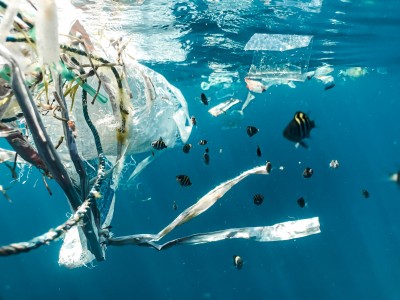Microplastics could worsen climate change
18 May 2022


By Liz Kivi
AN environmental physicist says plastics could be influencing climate change, potentially compounding the effect of greenhouse gases.
Laura Revell, University of Canterbury associate professor in Environmental Physics, says recent findings show that the atmosphere can transport large amounts of micro- and nano-plastics across continents and oceans very quickly, in a matter of days or weeks.
She has co-authored a review paper recently published in Nature Reviews Earth and Environment, which estimates that the amount of plastic moving between the ocean and the atmosphere is between 13,000 to 25 million metric tons per year. Revell says that this means the atmosphere is potentially a bigger source of marine microplastics than rivers.
Airborne microplastics have been found in the most remote places on Earth in similar amounts to findings in big cities. “We’ve found them in the Arctic and the Antarctic and everywhere in between. We now understand that they are transported throughout the atmosphere in the same way as other types of airborne particulate matter, such as dust or soot.
Grim reality
“Over time we’re accepting the grim reality that they’re ubiquitous, and everywhere we look we will find them.”
As well as having detrimental impacts on ecosystems and human health, the tiny plastics could be compounding the effect of GHGs. Revell has done an initial study that found microplastics in the atmosphere can alter temperatures, by both scattering and by absorbing light.
“We showed that they can both heat the atmosphere and cool it, so heat it by absorbing radiation emitted by the earth, behaving like a greenhouse gas. But they can also scatter sunlight. In our calculations, we showed that they had a cooling influence overall.”
But she’s quick to dispel any hopes that humans could harness the cooling effect to slow climate change, or that plastics in the atmosphere could ever be beneficial. “I’d hate people to think that this could be a good thing, because plastics have so many harmful effects on ecosystems and on human health.”
More data needed
She says more work needs to be done to supplement their initial findings. “We didn’t have data on coloured plastics to show how they interact with light, so that’s a gap that we’re working on filling at the moment. Their colour is going to have a big influence, absorbing light and likely to have a warming effect.”
Another way the microplastics could be affecting climate is by seeding cloud formation. “That is something that we hypothesise that hasn’t been tested yet. Time will tell.”
Another theory that needs to be tested is whether microplastics deposited on ice or snow would accelerate melting in icy regions. “Because microplastics are coloured, and colour absorbs sunlight, this can lead to heating.”
Emerging area of research
Revell says it’s a new area of research and worthy of a lot more study. “There’s so much more that we don’t know compared with what we do know.”
The atmosphere has only recently been considered as a pathway for microplastic transport and scientists have only started studying it in the past decade. “In 2015 it was known that between 15 trillion and 51 trillion microplastics are floating at the ocean surface, and in the same year microplastics were reported in the air for the first time.”
 |
|
Photo by Naja Bertolt Jensen on Unsplash. |
Revell is planning further study looking at the presence and abundance of microplastics in very remote regions such as the Antarctic and the Southern Ocean. “Understanding microplastics in really remote regions is useful because it helps us get an understanding of the impacts for the climate.”
She says microplastic pollution is only going to increase in future, because of the huge amount of plastic waste already in the environment. “There are loads of plastics built up in the natural environment to date and those will be breaking down and forming microplastics over time.”
The problem is a long-term one, similar to greenhouse gas pollution. “It’s exactly like GHGs. You can turn the tap off today but you will feel the effects of them for a very long time to come.”
She says it is encouraging that there will be an international treaty coming into play in 2024. “The scale of the problem is so big that we definitely need multiple governments committed to taking serious action on plastic production and transitioning to circular economies. We also need to pay careful attention to how we’re managing the plastic waste that is in the environment.”
Need to support developing nations
Revell would like to see the international community supporting developing countries, as currently that is where a lot of mismanaged plastic waste from developed countries ends up.
She says a plastics treaty should look to the Montreal Protocol, which committed to supporting developing nations as part of the process to reduce the use of ozone-depleting substances, and was very successful. “We need to consider providing support to developing nations rather than shipping our plastic to them, which we have been doing.”
As well as being pollutants in their own right, microplastics act as vectors for heavy metals and other pollutants. Revell says they are a particular concern in marine environments, where they can enter the food chain.
In the past few months, studies have uncovered microplastics in blood and in human lungs. This is unsurprising given their ubiquity and the fact they are small enough to be inhaled and ingested, but the long-term health effects are still unknown. “The effects aren’t good, as you would expect. We don’t expect that any study is going to show that microplastics are beneficial to human health in any way.”
Serious and harmful effects on human health
Revell says a recent study culturing lung tissue with polystyrene microbeads showed the cell’s shape changed and the function decreased. “Microplastics are having a serious and harmful effect on human health at a cellular level.”
Time will tell whether that level of harm extends to climate effects. “We want to know how widespread they are and what they’re doing. How they’re behaving in the atmosphere, how they’re contributing to global change and to cloud formation. Those are a lot of really big questions.”
print this story
Story copyright © Carbon News 2022










